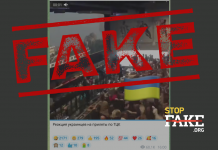Pro-Kremlin site Ukraina.ru published an article this week claiming that food prices in Ukraine have grown to equal those of Europe. This claim is based on a Facebook post by former Ukrainian Prime Minister Mykola Azarov, who served under ousted President Viktor Yanukovych. Azarov’s claim meanwhile is based on RIA Novosti’s data presented in an attractive but questionable infographic.


RIA Novosti’s data is not sourced, it is not clear where the agency got the figures it claims represent the real cost of food in Ukraine today. Not only does RIA Novosti present questionable data, it announces that according to experts, things will get even more expensive. The experts, of course, are not named.
In his post, Azarov claims that prices grew to European levels after Ukraine signed the EU Association agreement and opened its markets to European goods. Pro-Kremlin media eagerly seized on this claim of Azarov’s to declare “how European integration influences the price of food in Ukraine” and “Kyiv regime intent on making sure that food will cost more inUkraine than in Europe”.
Federalnoye Agentstvo Novostey, Golos Pravdy, Ukrop, Informburo.dn.ua, Glavnosti, DneprChas and other media outlets all disseminated this fake story.

A bit of searching on the web shows that RIA Novosti got its numbers from an article in the Ukrainian newspaper Segodnya. Segodnya claims its sources are the Economic Discussion Club (an economic think tank organized by former ministers, bankers and commodity traders) and its own calculations. Segodnya does not indicate what its calculations are based on and claims that the cost of a basket of goods bought by a typical Ukrainian shopper is gradually approaching the price paid by someone buying similar items in the European Union. The European countries Segodnya compares Ukrainian food prices to are Poland, France and Belarus.


According to Ukraine’s State Statistics Service, a government body that tracks economic and financial data, food prices really are rising, however, the consumer price index for 2017 was lower than 2015. The Economic Discussion Club’s analysis also shows that the minimal cost of the basket of goods changes through the year.


Segodnya compares Ukrainian consumer prices to those of Poland, a country which has some of the lowest food prices in Europe. According to the EU statistics agency Eurostat, if we take the average food prices for the European Union to be 100, then this ratio would have the value of 63 per cent for Poland.
Numbeo, a site that tracks the cost of living in different cities shows that in February 2018 food prices in Krakow supermarkets were on average 56% higher than in Kyiv. Certain staples, such as milk, were either equal in price or somewhat cheaper in Poland.
Eurostat data shows that consumer prices are rising in all European countries, not only in Ukraine. But it is worth noting that in 2017 the level of inflation in EU countries was an average of 1.5%, whereas in Ukraine it was nearly 14%. Official Ukrainian data shows that on average Ukrainians spent nearly half their income on food in 2016, whereas Europeans spent only 12%, according to Eurostat.

According to the Numbeo cost of living index, Ukraine is the least expensive country in Europe, along with Moldova, Macedonia and Albania. The site also compares prices on foodstuffs in various cities of the world, showing that Ukrainian prices on average, have a long way to go before they reach European levels.




